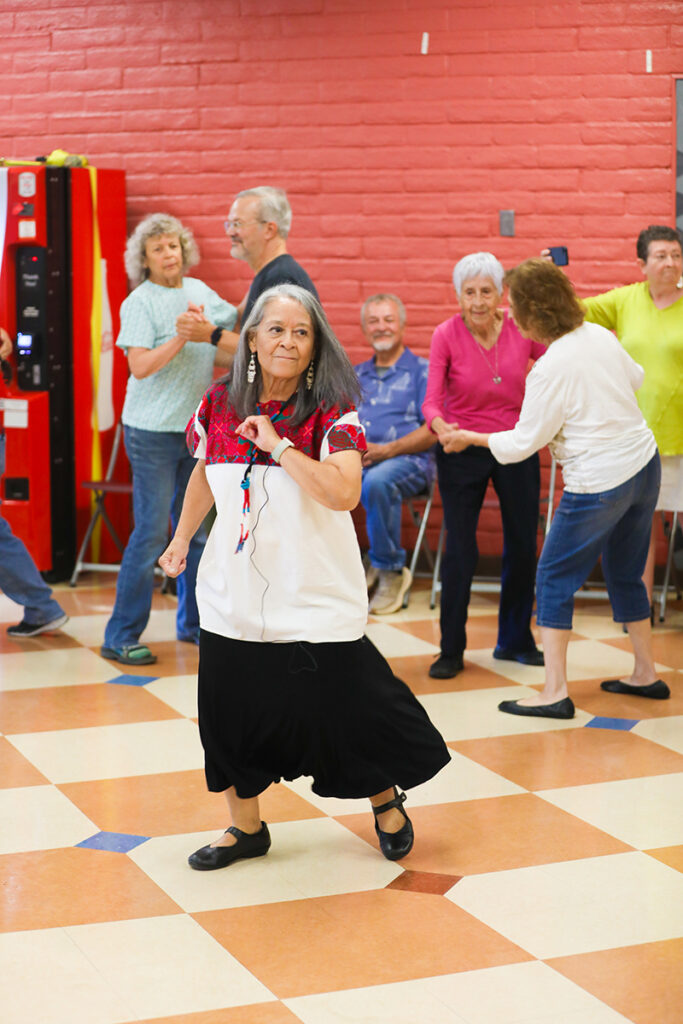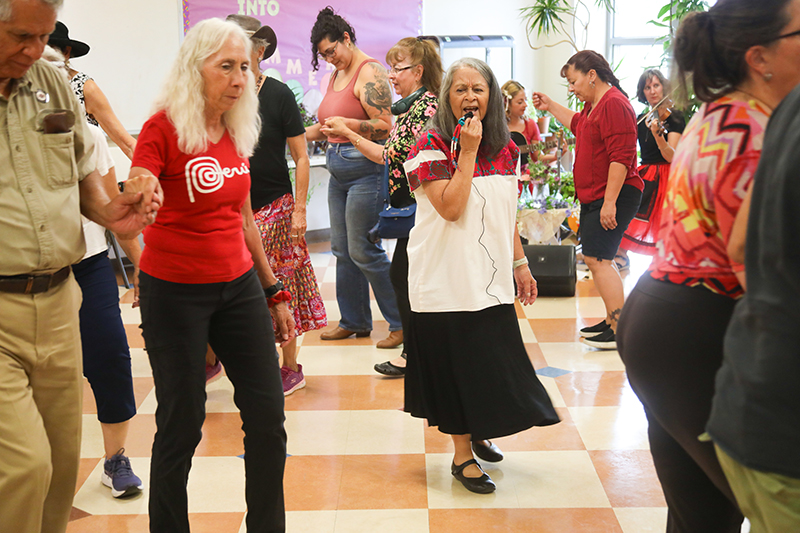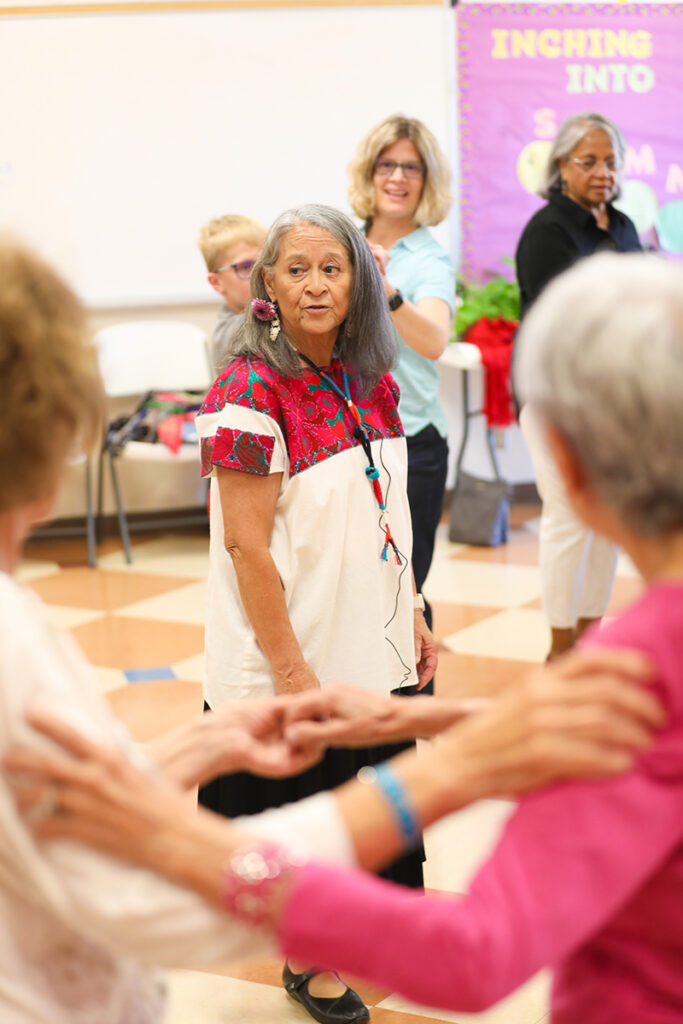Disappearing Dances
November 10, 2025
Los Bailes de Salón de Nuevo México
BY YVONNE MONTOYA
Photos by Andrés Salazar
Note: This article was published in Stance on Dance’s Fall/Winter 2025 print issue. To learn more, visit stanceondance.com/print-publication.
On a warm day in March in the small town of Mountainair, New Mexico, a group of mostly elder dancers decked out in jeans and cowboy boots trickled into the Manzano Mountain Arts Council. The dancers, some who traveled over an hour from Albuquerque, were there to attend a free Baile led by dance elder, tradition bearer, and master teacher of traditional Nuevomexicano[1] folk dances, Lucy Salazar.
Lucy is one of the last dancers to know and teach the traditional Nuevomexicano folk dances, or what Lucy calls, Los bailes de salón de Nuevo México. These dances, which were once danced regularly throughout Spanish-speaking Nuevomexicano communities in New Mexico and Southern Colorado, are on the verge of going extinct. With the average age of the dancers in their 70s to 90s, Los bailes de salón de Nuevo México are disappearing.

What are Los bailes de salón de Nuevo México and why are they disappearing?
I need to position myself in relationship to Los bailes de salón de Nuevo México. First and foremost, I am a 23rd-generation Nuevomexicana and descendant of the Mexicanos who the border crossed in 1848 at the end of the war between Mexico and the United States. Like my Nuevomexicano manitos[2], I am a nonimmigrant Latina whose mestizaje is of and from New Mexico. I have vague memories of dancing some of the Nuevomexicano folk dances with my family as a child. Specifically, I remember learning “La varceliana” outside in the mountains by taking turns dancing with my dad and maternal great-grandmother during a family reunion. I also remember a few Sundays in the summer when my dad pushed the living room furniture against the walls and tried in vain to teach my large family the complicated dance of “Las cuadrillas.” And of course, there is the traditional Nuevomexicano “La marcha de los novios” performed at every wedding I attended as a child. We may have even danced “La marcha” at my high school prom.
I met Lucy Salazar in September 2019 at La Sala de San José, one of the last remaining adobe dance halls in New Mexico, located in Galisteo. I was invited to attend a traditional Baile she led by Jordan Wax, a member of the band Lone Piñon, an orquesta típica nuevomexicana that plays traditional Nuevomexicano folk music. I met Jordan during a choreographic research trip I took to New Mexico in 2019 to study the traditional Nuevomexicano folk dances. As artistic director and choreographer of Safos Dance Theatre, a company grounded in Southwest cultural values and aesthetics, and as a former dancer trained in modern dance, my research question was: What are the contemporary movement aesthetics of Nuevomexicanos who have been living in Northern New Mexico for centuries? Can these folk forms inspire contemporary ways of movement true to the region? What could I learn from my Nuevomexicano dance elders?
After meeting Lucy, we kept in touch, growing a relationship throughout the years even though I live and work in Tucson, Arizona. I visit Lucy when I travel home to New Mexico, and I attend as many of Lucy’s dance events as my schedule allows. In 2023, Lucy graciously donated her time to coach me in “Querencia,” a stylized medley of Nuevomexicano Bailes de salón that I choreographed to be performed by me and my son in my touring work Stories from Home.

Los bailes de salón de Nuevo México
Los bailes de salón de Nuevo México are a series of nine dances:
- La valse de la escoba
- La valse se los paños
- La camilla
- La vaquera
- La varceliana or varsoviana
- El talean
- La cuna
- Las cuadrillas
- La marcha de los novios
All dances are based on three basic steps:
- Valse (waltz step)
- Polka estilo nuevomexicano (a New Mexico style polka step, which according to Lucy is distinct from polka steps used in other forms like Mexican Folklorico)
- Chotis
All are partner or group dances done in pairs or groups of three, four, or eight dancers.
All the dances are done to live music. In fact, Lucy rarely teaches dance without live musicians. This exemplifies the importance of the deep connection with musicians in this form. The tempo of each dance and how long the dance is performed is based on the musicians.
Los bailes de salón de Nuevo México were traditionally performed outdoors, in adobe dance halls, and in people’s homes. Lucy tells stories of family members moving furniture around living rooms to create makeshift dance floors where people of all ages would dance together late into the night, stopping only when the musicians were tired. The Bailes ‘were intergenerational and open to everyone.
Los bailes de salón de Nuevo México reflect the storied history of the state. “La vaquera” is a chotis and most likely originally from Spain. It arrived in New Mexico during the first two European colonizations of the area by the Spanish colonial empire in 1598 and 1693. “La varceliana” or “varsoviana” most likely found its way to New Mexico in the 1800s along the Santa Fe Trail.
The music for “La marcha” is strikingly similar to the “Marcha de Zacatecas” from Zacatecas, Mexico. In fact, sometimes the actual song “La marcha de Zacatecas” is used to perform “La marcha” at Nuevomexicano weddings. Lucy states that, “‘La marcha’ is traditionally done to music by Gregorio Ruiz or Lorenzo Martínez. The actual Marcha is very unique to this area. It is based on the European custom of presenting the court. It is usually led by the padrinos of the novios who lead the novios and the wedding party through the formations. The formations represent the course of married life including separations, reunions, trials, tribulations, and joys.” The similarity between music for “La marcha” and the “Marcha de Zacatecas” shows New Mexico’s longstanding connection to Mexico as former territory both during the centuries-long Spanish colonial period as well as after Mexico’s independence from Spain[3].

Disappearing Dances
I believe that the loss of the folk dances of Nuevo México is directly related to the loss of the Spanish language across Nuevomexicano communities. During the 1940s, the United States government implemented Americanization programs in non-English-speaking communities in New Mexico[4]. These programs corporally punished young elementary-age Nuevomexicano students for speaking Spanish in school. Additionally, Americanization programs altered students’ names to more Anglicized versions and berated children for wearing traditional clothing. As a result, traditional New Mexican Spanish dialect will be gone within 15 years, when all remaining native speakers of the language pass on.
The loss of the Spanish language for Nuevomexicanos was like a sharp sword severing the thread that connected younger generations to our ancestors and raices (roots). The inability to communicate with and learn from elders (case in point, my great-grandmother born in Truchas, New Mexico, in 1911, did not speak English) combined with many Nuevomexicanos’ economic displacement by leaving rural communities for Albuquerque or larger cities out of state. As a result, the traditional dances were performed less and less.
Except for “La marcha,” most Bailes de salón de Nuevo México were not taught to younger generations, mine included. Lucy’s generation is the last to know all the traditional Bailes de salón. While some of these dances may be performed by other communities both in the United States and throughout Latin America, the styles and aesthetics of the Nuevomexicano versions are unique.

Lucy Salazar and Nuevomexicano Dance Legacy
Lucy learned traditional New Mexico folk dances from her parents. She says, “I’ve been a dancer my entire life. I would accompany my parents to local social dances or just dances de gusto, you know, because everybody wanted to dance. Let’s get together at somebody’s house and we’ll all dance. My heart and soul are in that because I just love it. It’s that whole querencia of where we’re from and what I do. I like to call it generational joy.”
Lucy’s personal mission is to “continue to share my love for this art form with Nuevomexicanos and others interested in learning and preserving traditional cultural dances from Northern New Mexico. I strongly believe that this positively impacts the youth of our community, instilling pride in our cultural traditions. These traditions are an essential part of who we are as Nuevomexicanos and contribute to building self-esteem, confidence, and success in all areas of life. Encouraging the younger generation through positive social activities where they can interact with others is crucial.”
Lucy teaches Nuevomexicano folk dances anywhere she can, including an ongoing class for seniors at the National Hispanic Cultural Center in Albuquerque. She often organizes Bailes around the central and northern parts of New Mexico, paying fellow dancers and musicians out of her own pocket. In 2024, she taught a session of Los bailes de salón de Nuevo México as part of the Asociación Nacional de Grupos Folklóricos (ANGF), a conference for Mexican Folklorico dancers. Currently, Lucy is mentoring an apprentice on how to teach the dances.
It is important to note that Lucy never teaches a class alone. She brings family and friends to help co-teach, including Agapita “Pita” Jáquez-Hopkins, Alicia Gonzales, and Lorenzo Montoya. Lucy’s apprentice Elisa Gagliano also assists in leading workshops. It takes a team to teach and share these dances.
Lucy recently began writing a book on Los bailes de salón. She says, “I hope this book will serve as a resource for future generations. While other books exist, I find their notation confusing, and I aim to create something more accessible to everyone in the community. The book includes a compilation of dances and choreographies, complete with historical narratives, dance descriptions, music, and diagrams.”
There is not a lot of research about these disappearing dances. I recently mentioned the preservation work Lucy is doing to Dr. Jennifer Jenkins, director of the Southwest Center at the University of Arizona. She sent me a quick literature review on Nuevomexicano folk dances. Los bailes de salón de Nuevo México were nowhere to be found.
Los bailes de salón de Nuevo México: Embodied Querencia
It is important that dancers and scholars learn from Lucy and her cohort while we still can. As for Lucy, she has big dreams of publishing her book, creating a YouTube series, and even aspires to lead a Baile at Jacob’s Pillow.
Lucy is singlehandedly spearheading the preservation of Los bailes de salón de Nuevo México, fighting to ensure their survival for generations to come. Lucy’s work is a true act of embodied querencia[5] as she shares with younger generations of Nuevomexicanos the dances of our ancestors. These are the Bailes our great-great-grandparents danced when they came together in community after a long day working the ejido[6]. These are the dances our great-great-grandparents danced as they fell in love. For Nuevomexicanos, these dances can be a deep embodied connection to our ancestors, despite the loss of our language and the economic displacement from our traditional communities.
Let’s dance together, in an adobe dance hall or outside in the fresh mountain air. Let’s dance querencia together, so that the folk dances of Nuevo México, the dances of my ancestors, do not disappear.

~~
[1] Nuevomexicano is the term I use to identify descendants of Spanish-speaking peoples who have been living in Northern New Mexico since the Spanish colonial period. I use the ‘o’ rather than a gender-neutral ‘e’ or ‘x’ due to community preference.
[2] Manitos is a name Nuevomexicanos used to call one another. It is derived from the Spanish word “Hermanito” or little brother.
[3] Most Spanish-speaking peoples who arrived in New Mexico with the Oñate expedition in 1598 during the first colonization came from Zacatecas, Mexico.
[4] For more information see Montoya, Yvonne (2005) “‘ASINA NOS CRIARON’: Contesting the Narratives and Claiming Place in the Atomic Age:1912-1955.”
[5] Querencia in this context is defined as a general deep connection to land, people, and place.
[6] An ejido is a communal land grant common in New Mexico during the Spanish colonial and Mexican periods.

Responses
There are no comments at this time.
Be the first to start the discussion by filling out the comment form.